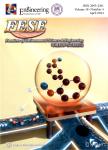Hydrologic experiments and modeling of two laboratory bioretention systems under different boundary conditions
Hydrologic experiments and modeling of two laboratory bioretention systems under different boundary conditions作者机构:Department of Civil Architectural and Environmental Engineering Hubei University of Technology Wuhan 430068 China Department of Civil Environmental and Ocean Engineering Stevens Institute of Technology Hoboken NJ 07030 USA
出 版 物:《Frontiers of Environmental Science & Engineering》 (环境科学与工程前沿(英文))
年 卷 期:2017年第11卷第4期
页 面:83-92页
核心收录:
学科分类:0820[工学-石油与天然气工程] 082001[工学-油气井工程] 0830[工学-环境科学与工程(可授工学、理学、农学学位)] 08[工学] 0813[工学-建筑学]
基 金:China Scholarship Council [ 3006] University of Auckland
主 题:Bioretention Hydrologic process Underdrain configuration SWMM Modeling
摘 要:Hydrologic performance of bioretention systems is significantly influenced by the media composition and underdrain configuration. This research measured hydrologic performance of column-scale bioretention systems during a synthetic design storm of 25.9 mm, assuming a system area:catchment area ratio of 5%. The laboratory experiments involved two different engineered media and two different drainage configurations. Results show that the two engineered mediawith different sand aggregates were able to retain about 36% of the inflow volume with tree drainage conlaguratlon. However, the medium with marine sand is better at delaying the occurrence of drainage than the one with pumice sand, denoting the better detention ability of the former. For both engineered media, an underdrain configuration with internal water storage (IWS) zone lowered drainage volume and peak drainage rate as well as delayed the occurrence of drainage and peak drainage rate, as compared to a free drainage configuration. The USEPA SWMM v5.1.11 model was applied for the tree drainage configuration case, and there is a reasonable fit between observed and modeled drainag.e-rates when media-specific characteristics are available. For the IWS drainage configuration case, air entrapment was observed to occur in the engineered medium with manne sand. F^lhng ot an IWS zone is most likely to be influenced by many factors, such as the structure of the bioretention system, medium physical and hydraulic properties, and inflow characteristics. More research is needed on the analysis and modeling of hydrologic process in bioretention with IWS drainage configuration.



